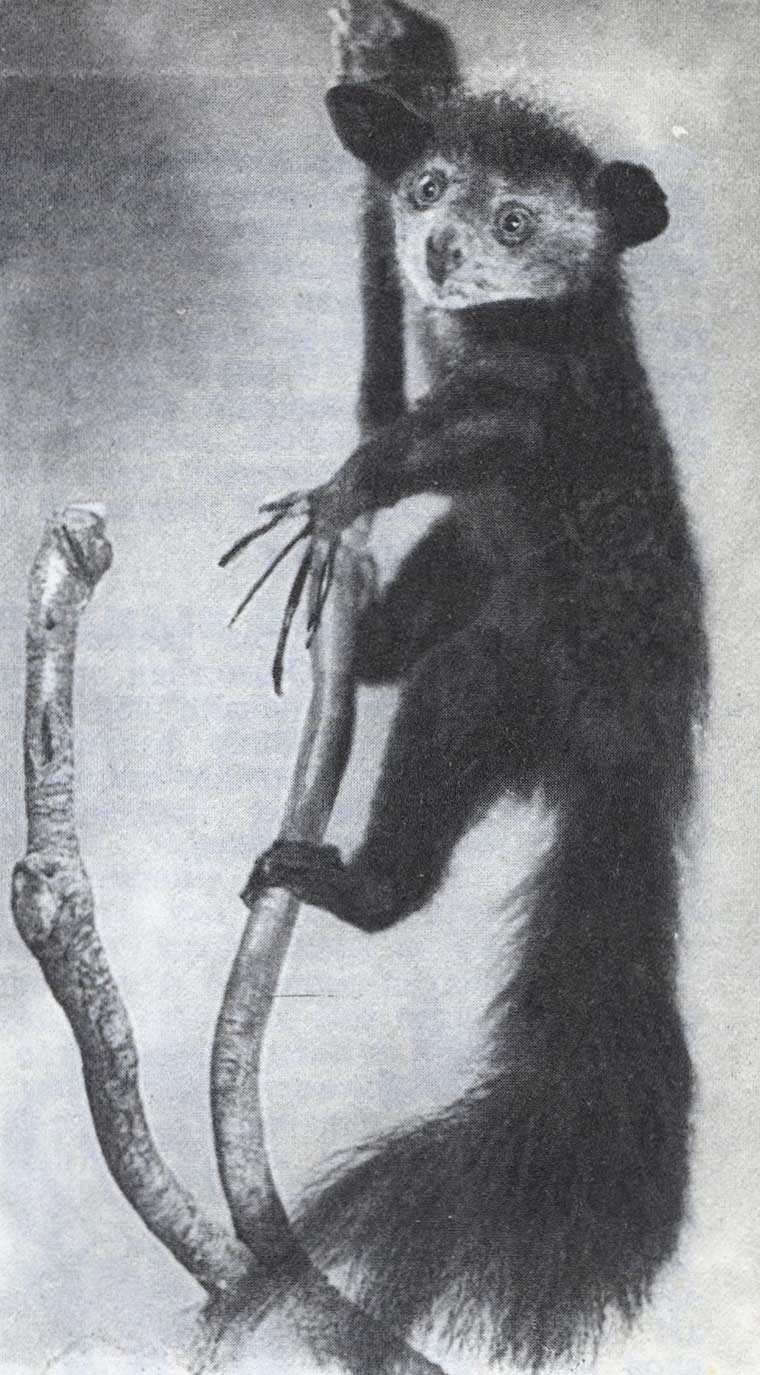 Он ведет очень скрытный образ жизни. Местные жители боятся встречи с ним. Его окружают суеверия. Это ай-ай — одно из самых поразительных животных, сохранившееся со времен глубокой древности.
Он ведет очень скрытный образ жизни. Местные жители боятся встречи с ним. Его окружают суеверия. Это ай-ай — одно из самых поразительных животных, сохранившееся со времен глубокой древности.  Он ведет очень скрытный образ жизни. Местные жители боятся встречи с ним. Его окружают суеверия. Это ай-ай — одно из самых поразительных животных, сохранившееся со времен глубокой древности.
Он ведет очень скрытный образ жизни. Местные жители боятся встречи с ним. Его окружают суеверия. Это ай-ай — одно из самых поразительных животных, сохранившееся со времен глубокой древности.
Ай-ай — животное настолько своеобразное, что ломаешь голову в бесплодной надежде найти родственника этому странному созданию. И все же родня у него есть. Это обезьяны. Как и у них, у ай-ай очень много общего в строении рук и ног, поэтому его назвали еще руконожкой.
Длинный, словно иссохший, палец на передней лапке и крупные передние зубы делают ай-ай похожим на грызуна. Питается же руконожка тем же, что и ежик, крот и другие насекомоядные животные, — насекомыми и их личинками. Днем ай-ай спит, а в сумерках путешествует по деревьям в поисках корма. Выстукивая длинным пальцем стволы, руконожка по звуку находит ходы личинок. Запустив зубы в дерево, ай-ай вскрывает ходы и достает личинки тем же длинным тонким пальцем.
Это удивительное создание было открыто 150 лет назад путешественником Пьером Соннера в лесах Мадагаскара. Остров Мадагаскар знаменит своим особым животным миром: там совсем нет обезьян, но зато очень много их древних родичей лемуров. Наш ай-ай тоже лемур, избравший особый жизненный путь, не свойственный никому из его сородичей. Поэтому у руконожки нет конкурентов. Нет у нее и серьезных врагов среди местных хищников. Аборигены Мадагаскара также не преследуют ай-ай, так как, по их поверьям, в лемуров переселяются души умерших.
Несмотря на такие благоприятные условия, руконожка, которая сохранила с очень давних времен и свой внешний вид и прежний образ жизни, становится редкостью. Ее родная стихия — девственные леса Мадагаскара вырубаются. Не шумят больше деревья, нет и насекомых.
К новым условиям жизни руконожка со своими древними, своеобразными обычаями приспособиться не может. Поэтому сохранить этого зверька помогут только заповедники. В зоопарках ай-ай почти нет: зверек он редкий, на охоту выходит по ночам, и поймать его трудно. Увидеть руконожку можно только в музее.
П. Смолин
He leads a very secretive lifestyle. Local residents are afraid of meeting him. Superstitions surround him. This aye-aye is one of the most amazing animals preserved from ancient times.
Aye-aye is an animal so unique that you rack your brains in the fruitless hope of finding a relative of this strange creature. And yet he has relatives. These are monkeys. Like them, the aye-aye has a lot in common in the structure of its arms and legs, which is why it was also called the little arm.
The long, as if withered, toe on the front paw and large front teeth make the aye-aye look like a rodent. The little monkey feeds on the same thing as the hedgehog, mole and other insectivorous animals - insects and their larvae. The aye-aye sleeps during the day, and at dusk it travels through the trees in search of food. Tapping the trunks with a long finger, the little arm finds the passages of the larvae by sound. Having sunk its teeth into the tree, the aye-aye opens the passages and takes out the larvae with the same long thin finger.
This amazing creature was discovered 150 years ago by traveler Pierre Sonnera in the forests of Madagascar. The island of Madagascar is famous for its special animal world: there are no monkeys there, but there are a lot of their ancient relatives, lemurs. Our aye-aye is also a lemur, having chosen a special path in life, not typical of any of its relatives. Therefore, the little hand has no competitors. She also has no serious enemies among local predators. The natives of Madagascar also do not pursue aye-ayes, since, according to their beliefs, the souls of the dead move into lemurs.
Despite such favorable conditions, the little arm, which has retained both its appearance and its former way of life since very ancient times, is becoming a rarity. Her native element - the virgin forests of Madagascar - are being cut down. The trees no longer make noise, and there are no insects.
The little hand with its ancient, peculiar customs cannot adapt to new living conditions. Therefore, only nature reserves will help preserve this animal. There are almost no aye-ayes in zoos: it is a rare animal, goes out hunting at night, and is difficult to catch. You can only see the little hand in a museum.
P. Smolin
***